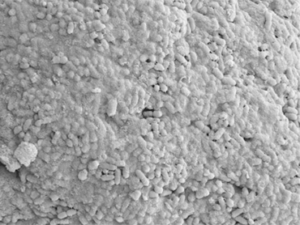Plague and Yersinia pestis
INSERM U1019 – CNRS UMR9017 – Lille University – CHU Lille – Institut Pasteur de Lille

Presentation
The team aims to gain a better understanding of the mechanisms responsible for arthropod-borne diseases in general, and plague in particular. Plague is a fatal disease transmitted by fleas and caused by the bacterium Yersinia pestis. Contrary to popular belief, plague has not disappeared. Indeed, plague remains an international and reemerging public health issue, accentuated by the emergence of antibiotic-resistant plague bacilli and the risk of this bacilli being used for fraudulent purposes (bioterrorism).
Highlights
- For many years, our team has been working to identify new genes that allow Y. pestis to produce the disease in mammals, with the aim of developing new vaccines and therapeutic strategies against plague. In addition to better understanding the mechanisms by which Y. pestis colonizes a mammal, we have identified the limitations of the acellular plague vaccines under development and proposed a strategy to improve them. With our collaborators at Duke University (USA), we have also developed a new class of antibiotics to cure the disease. Furthermore, we have shown that these new antibiotics are active against a broad spectrum of Gram-negative bacteria that are highly resistant to multiple antibiotics and constitute a major public health problem in our countries.
- For nearly 10 years, part of our team has also been working to elucidate the mechanisms used by Y. pestis to produce a transmissible infection in fleas. The fruit of our work has led to a better understanding of the pathophysiology of the disease in the insect and the identification of new Y. pestis genes required for the infection thanks to our development of an innovative technology (allowing the screening of many Y. pestis mutants at relatively high throughput in the insect). Based on our data, we were able to discover new molecular mechanisms used by the bacillus to be transmitted by fleas. This work opens the door for new strategies to control the spread of the plague.
- For nearly 10 years, part of our team has also been working to elucidate the mechanisms used by Y. pestis to produce a transmissible infection in fleas. Our work has led to a better understanding of the pathophysiology of the disease in the insect and to the identification of new Y. pestis genes required for infection thanks to the development of an innovative technology (allowing the screening of numerous bacterial mutants at a relatively high throughput in the insect). Based on our data, we were able to discover new molecular mechanisms used by the bacillus to be transmitted by fleas. This work paves the way for new strategies to control the spread of the plague.
Members
Florent SEBBANE
DR2 Inserm, group leader
ORCID number : 0000-0003-3811-9691
Nadine LEMAITRE
PU-PH
ORCID number : 0000-0002-0011-3596
Sébastien BONTEMPS-GALLO
CRCN, CNRS
ORCID number : 0000-0002-1834-5416
Michael MARCEAU
MCU, Univ Lille
ORCID number : 0000-0002-4403-8081
François PIERRE
Research engineer, Univ Lille
ORCID number : 0000-0002-7067-062X
Alexandre BAILLEZ,
PhD Student, Univ Lille
ORCID number : 0009-0008-0736-6693
Amélie DEWITTE
Study Engineer, Inserm
ORCID number :0009-0005-9192-216X
Maurane DEGARDIN,
PhD Student, Univ Lille
Brandon ROBIN
Post-doc, IPL
ORCID number : 0000-0002-5851-3744
Agustin ROLANDELLI
Post-doc, IPL
ORCID number : 0000-0003-1059-3578
Camille DUPONT,
Technician, Inserm
El Hadji Ibrahim NDIAYE
Post-doc Inserm
ORCID number : 0009-0005-5788-9191
Alexandre BANTZ
Post-doc Inserm
ORCID number :0000-0003-4095-4418
Camille HAGNERE
Study engineer, IPL
Francisco ALBICORO
Post-doc, IPL
Numéro ORCID : 0000-0001-5460-3534
Henri LOSHOUARN
Post-doc IPL
Numéro ORCID : 0009-0005-5360-3432
Publications
Lemaître N, Liang X, Najeeb J, Lee CJ, Titecat M, Leteurtre E, Simonet M, Toone EJ, Zhou P, Sebbane F.
Curative Treatment of Severe Gram-Negative Bacterial Infections by a New Class of Antibiotics Targeting LpxC.
MBio, 2017, 25;8(4): e00674-17.
Daniel C, Dewitte A, Poiret S, Marceau M, Simonet M, Marceau L, Descombes G, Boutillier D, Bennaceur N, Bontemps-Gallo S, Lemaître N, Sebbane F.
Polymorphism in the Yersinia LcrV Antigen Enables Immune Escape From the Protection Conferred by an LcrV-Secreting Lactococcus Lactis in a Pseudotuberculosis Mouse Model.
Frontiers in Immunology, 2019, 2;10: 1830.
Gandon S, Heitzmann L, Sebbane F.
To block or not to block: The adaptive manipulation of plague transmission.
Evolution Letters, 2019, 27;3(2):152-161.
Bontemps-Gallo S, Fernandez M, Dewitte A, Raphaël E, Gherardini FC, Elizabeth P, Koch L, Biot F, Reboul A, Sebbane F.
Nutrient depletion may trigger the Yersinia pestis OmpR-EnvZ regulatory system to promote flea-borne plague transmission.
Molecular Microbiology, 2019, 112(5):1471-1482.
Dewitte A, Bouvenot T, Pierre F, Ricard I, Pradel E, Barois N, Hujeux A, Bontemps-Gallo S, Sebbane F.
A refined model of how Yersinia pestis produces a transmissible infection in its flea vector.
PLoS Pathogens, 2020, 16(4):e1008440.
Keywords
Pestis ; Yersinia pestis ; Flea ; Mechanisms of infection ; Vaccine ; Antibiotherapy
Contact équipe
Florent Sebbane
Group leader
florent.sebbane@ibl.cnrs.fr
03 20 87 11 93


